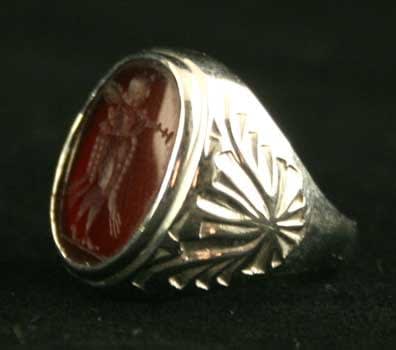Gold Ring Featuring a Roman Carnelian Intaglio Depicting a Hunter, 100 CE - 300 CE
Carnelian, Gold
FJ.6825
This Genuine Ancient Seal Has Been Set in a Modern 18 Karat White Gold Rin The art of glyptics, or carving images on colored precious stones, is probably one of...
This Genuine Ancient Seal Has Been Set in a Modern 18 Karat White Gold Rin
The art of glyptics, or carving images on colored precious stones, is probably one of the oldest known to humanity. Intaglios, gems with an incised design, were made as early as the fourth and third millennia B.C. in Mesopotamia and the Aegean Islands. They exhibit a virtuosity of execution that suggests an old and stable tradition rooted in the earliest centuries. The tools required for carving gems were simple: a wheel with a belt-drive and a set of drills. Abrasives were necessary since the minerals used were too hard for a metal edge. A special difficulty of engraving intaglios, aside from their miniature size, was that the master had to work with a mirror-image in mind.
The image of a hunter returning from the hunt has been engraved onto the polished surface of this precious gemstone. He proudly carries the unfortunate prey draped over his shoulders as if a cloak. The hunter proudly brandishes his large club, no doubt the weapon that finished off the game. This victorious hunter would return to his village as a hero, for he has provided the basis of a great feast. The glyptic artist has clearly tried to associate this hunter with the mighty hero Herakles. The prominent club is similar to the weapon brandished by the hero and the dead game that he carries over his back recalls the lion skin worn by Herakles. This gorgeous ring is a reminder or the joys of the hunt, of the pursuit, the kill, and the prize. The time-honored tradition of the hunt has the power to turn and ordinary man into a hero worthy of the stature of Herakles himself.
The art of glyptics, or carving images on colored precious stones, is probably one of the oldest known to humanity. Intaglios, gems with an incised design, were made as early as the fourth and third millennia B.C. in Mesopotamia and the Aegean Islands. They exhibit a virtuosity of execution that suggests an old and stable tradition rooted in the earliest centuries. The tools required for carving gems were simple: a wheel with a belt-drive and a set of drills. Abrasives were necessary since the minerals used were too hard for a metal edge. A special difficulty of engraving intaglios, aside from their miniature size, was that the master had to work with a mirror-image in mind.
The image of a hunter returning from the hunt has been engraved onto the polished surface of this precious gemstone. He proudly carries the unfortunate prey draped over his shoulders as if a cloak. The hunter proudly brandishes his large club, no doubt the weapon that finished off the game. This victorious hunter would return to his village as a hero, for he has provided the basis of a great feast. The glyptic artist has clearly tried to associate this hunter with the mighty hero Herakles. The prominent club is similar to the weapon brandished by the hero and the dead game that he carries over his back recalls the lion skin worn by Herakles. This gorgeous ring is a reminder or the joys of the hunt, of the pursuit, the kill, and the prize. The time-honored tradition of the hunt has the power to turn and ordinary man into a hero worthy of the stature of Herakles himself.



